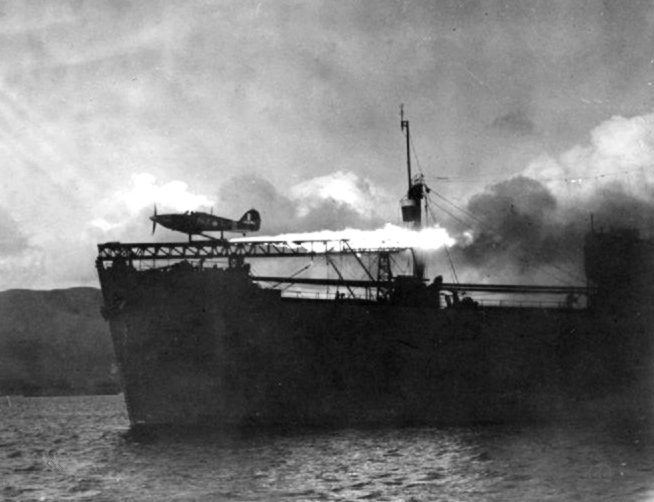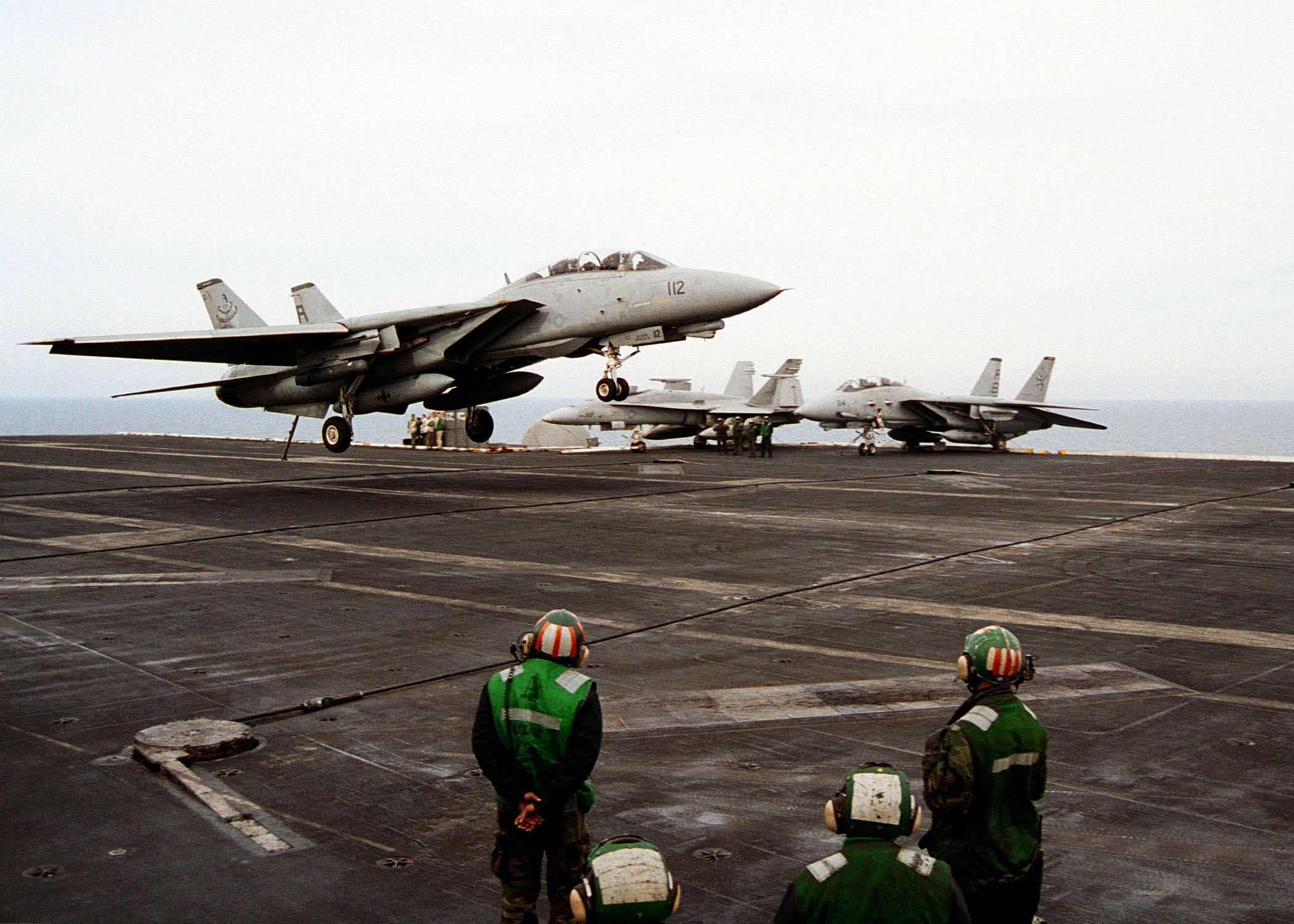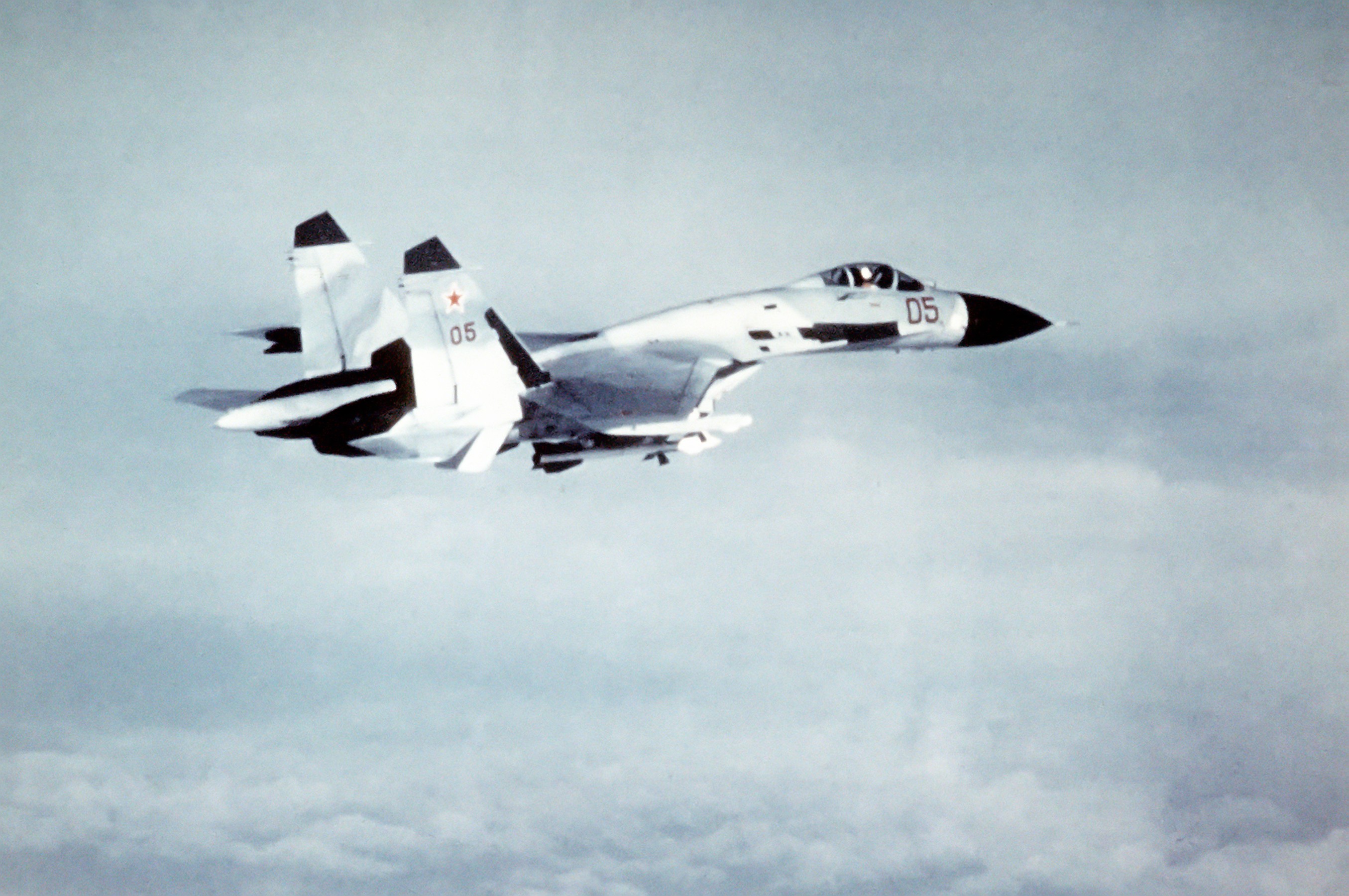|
STOBAR
STOBAR ("short take-off but arrested recovery" or "short take-off, barrier-arrested recovery") is a system used for the launch and recovery of aircraft from the deck of an aircraft carrier, combining elements of "short take-off and vertical landing" (STOVL) with "catapult-assisted take-off but arrested recovery" ( CATOBAR). Aircraft launch under their own power using a ski-jump to assist take-off (rather than using a catapult). However, the planes are conventional, rather than STOVL aircraft, and thus require arrestor wires to land on the ship. The STOBAR system is simpler to build than CATOBAR. , it has been used widely on Russian, Indian, and Chinese carriers. Advantages Compared to CATOBAR, STOBAR is less expensive to develop. It is easier to operate than a CATOBAR configuration, which requires large number of operators to launch the aircraft. The lack of any moving parts in a ski-jump makes it less expensive to maintain than a catapult. It does not require any additional ... [...More Info...] [...Related Items...] OR: [Wikipedia] [Google] [Baidu] |
Aircraft Carrier
An aircraft carrier is a warship that serves as a seagoing airbase, equipped with a full-length flight deck and hangar facilities for supporting, arming, deploying and recovering carrier-based aircraft, shipborne aircraft. Typically it is the capital ship of a naval fleet, fleet (known as a carrier battle group), as it allows a naval force to power projection, project seaborne naval aviation, air power far from homeland without depending on local airfields for staging area, staging aerial warfare, aircraft operations. Since their inception in the early 20th century, aircraft carriers have evolved from wooden vessels used to deploy individual tethered reconnaissance balloons, to nuclear marine propulsion, nuclear-powered supercarriers that carry dozens of fighter aircraft, fighters, strike aircraft, military helicopters, airborne early warning and control, AEW&Cs and other types of aircraft such as unmanned combat aerial vehicle, UCAVs. While heavier fixed-wing aircraft such as a ... [...More Info...] [...Related Items...] OR: [Wikipedia] [Google] [Baidu] |
INS Vikramaditya
INS ''Vikramaditya'' ()Literally ''Vikramaditya'' translates as being "Sun (Aditya) of valour" (Vikram). The component ''āditya'' (sun) literally means "he who belongs to Aditi". It was the title of the most famous Indian king in Indian history, Vikramaditya of Ujjain, famed as a noble ruler and a mighty warrior. The ruler ruled between 380 and 413/15 AD. . is a modified and the flagship of the Indian Navy. The carrier entered into service in 2013. Originally built as ''Baku'' and commissioned in 1987, the carrier served with the Soviet Navy and later with the Russian Navy (as ''Admiral Gorshkov'') before being decommissioned in 1996. After years of negotiations, the carrier was purchased by India on 20 January 2004. The transformed ship completed her sea trials in July 2013 and first STOBAR aviation trials in September 2013. She was commissioned on 16 November 2013 at a ceremony held at Severodvinsk, Russia. On 14 June 2014, the Prime Minister of India, Narendra Modi, fo ... [...More Info...] [...Related Items...] OR: [Wikipedia] [Google] [Baidu] |
CATOBAR
CATOBAR (catapult-assisted take-off but arrested recovery or catapult-assisted take-off barrier arrested recovery) is a system used for the launch and recovery of aircraft from the deck of an aircraft carrier. Under this technique, aircraft launch using a catapult- assisted take-off and land on the ship (the recovery phase) using arrestor wires. Although this system is costlier than alternative methods, it provides greater flexibility in carrier operations, since it imposes less onerous design elements on fixed wing aircraft than alternative methods of launch and recovery such as STOVL or STOBAR, allowing for a greater payload for more ordnance and/or fuel. CATOBAR can launch aircraft that lack a high thrust to weight ratio, including heavier non-fighter aircraft such as the E-2 Hawkeye and Grumman C-2 Greyhound. Types The catapult system in use in most modern CATOBAR carriers is the steam catapult. Its primary advantage is the amount of power and control it can provide. Duri ... [...More Info...] [...Related Items...] OR: [Wikipedia] [Google] [Baidu] |
Aircraft Ski-jump
In aviation, a ski-jump is an upwardly curved ramp that allows a fixed-wing aircraft to take off from a runway that is shorter than the aircraft normally requires. By providing an upward vector from the ski-jump's normal force, the aircraft is launched at an elevated angle and lift-off can be achieved at a lower airspeed than that required for flat takeoff, as it allows the aircraft more time to continue accelerating while airborne after leaving the runway. Ski-jumps are commonly used to launch shipborne aircraft from aircraft carriers that lack catapults. It is believed that the first use of the ski-jump occurred during the Second World War, when a temporary ramp was added to to help heavily laden Fairey Barracudas attack the German battleship . During the Cold War, the concept was studied as a means of reducing the length of flight decks required for aircraft carriers and to facilitate ever-heavier aircraft at sea. The Royal Navy took a particular interest in the ski-jump ... [...More Info...] [...Related Items...] OR: [Wikipedia] [Google] [Baidu] |
Aircraft Catapult
An aircraft catapult is a device used to help fixed-wing aircraft gain enough airspeed and lift for takeoff from a limited distance, typically from the deck of a ship. They are usually used on aircraft carrier flight decks as a form of assisted takeoff, but can also be installed on land-based runways, although this is rare. The catapult used on aircraft carriers consists of a track or slot built into the flight deck, below which is a large piston or ''shuttle'' that is attached through the track to the nose gear of the aircraft, or in some cases a wire rope, called a catapult bridle, is attached to the aircraft and the catapult shuttle. Other forms have been used historically, such as mounting a launching cart holding a seaplane on a long girder-built structure mounted on the deck of a warship or merchant ship, but most catapults share a similar sliding track concept. Different means have been used to propel the catapult, such as weight and derrick, gunpowder, flywheel, co ... [...More Info...] [...Related Items...] OR: [Wikipedia] [Google] [Baidu] |
Arrestor Wires
An arresting gear, or arrestor gear, is a mechanical system used to rapidly decelerate an aircraft as it lands. Arresting gear on aircraft carriers is an essential component of naval aviation, and it is most commonly used on CATOBAR and STOBAR aircraft carriers. Similar systems are also found at land-based airfields for expeditionary or emergency use. Typical systems consist of several steel wire ropes laid across the aircraft landing area, designed to be caught by an aircraft's tailhook. During a normal arrestment, the tailhook engages the wire and the aircraft's kinetic energy is transferred to hydraulic damping systems attached below the carrier deck. There are other related systems that use nets to catch aircraft wings or landing gear. These ''barricade'' and ''barrier'' systems are only used for emergency arrestments for aircraft without operable tailhooks. History Arresting cable systems were invented by Hugh Robinson and were used by Eugene Ely on his first landing ... [...More Info...] [...Related Items...] OR: [Wikipedia] [Google] [Baidu] |
HAL Tejas
The HAL Tejas () is an Indian single-engine, delta wing, Multirole combat aircraft, multirole Military aircraft, combat aircraft designed by the Aeronautical Development Agency (ADA) and manufactured by Hindustan Aeronautics Limited (HAL) for the Indian Air Force (IAF) and the Indian Navy. Tejas made its first flight in 2001 and entered into service with the IAF in 2015. In 2003, the aircraft was officially named 'Tejas'. Currently, Tejas is the smallest and lightest in its class of supersonic fighter jets.'' '' Tejas is the second jet powered combat aircraft developed by Hindustan Aeronautics Limited, HAL, after the HAL HF-24 Marut, HF-24 Marut. The first Tejas squadron became operational in 2016. The No. 45 Squadron IAF (''Flying Daggers'')'','' based at Sulur Air Force Station (AFS) in the southern Indian state of Tamil Nadu, was the first to have their MiG-21 ''Bisons'' replaced with the Tejas. Tejas has three production variants - Mark 1, Mark 1A and a trainer/light attack ... [...More Info...] [...Related Items...] OR: [Wikipedia] [Google] [Baidu] |
Shenyang J-15
The Shenyang J-15 (wikt:歼, Chinese: 歼-15), also known as ''Flying Shark'' (; NATO reporting name: Flanker-X2, Flanker-K) is a Chinese night fighter, all-weather, twinjet, twin-engine, carrier-based aircraft, carrier-based Fourth-generation fighter#4.5 generation, 4.5 generation multirole combat aircraft, multirole fighter aircraft developed by the Shenyang Aircraft Corporation (SAC) and the Shenyang Aircraft Design Institute, 601 Institute, specifically for the People's Liberation Army Naval Air Force (PLANAF) to serve on People's Liberation Army Navy's (PLAN) Chinese aircraft carrier programme, aircraft carriers. The aircraft entered active service with the PLAN in 2013. An improved variant, named J-15T, incorporating CATOBAR launch capability, modern Fifth-generation fighter, fifth-generation avionics, entered active service in the South China Sea in October 2024. The J-15 is to be replaced by the naval variant of the fifth-generation fighter Shenyang J-35. Development In ... [...More Info...] [...Related Items...] OR: [Wikipedia] [Google] [Baidu] |
Soviet Union
The Union of Soviet Socialist Republics. (USSR), commonly known as the Soviet Union, was a List of former transcontinental countries#Since 1700, transcontinental country that spanned much of Eurasia from 1922 until Dissolution of the Soviet Union, it dissolved in 1991. During its existence, it was the list of countries and dependencies by area, largest country by area, extending across Time in Russia, eleven time zones and sharing Geography of the Soviet Union#Borders and neighbors, borders with twelve countries, and the List of countries and dependencies by population, third-most populous country. An overall successor to the Russian Empire, it was nominally organized as a federal union of Republics of the Soviet Union, national republics, the largest and most populous of which was the Russian SFSR. In practice, Government of the Soviet Union, its government and Economy of the Soviet Union, economy were Soviet-type economic planning, highly centralized. As a one-party state go ... [...More Info...] [...Related Items...] OR: [Wikipedia] [Google] [Baidu] |
Sukhoi Su-27
The Sukhoi Su-27 (; NATO reporting name: Flanker) is a Soviet Union, Soviet-origin twinjet, twin-engine supersonic Supermaneuverability, supermaneuverable fighter aircraft designed by Sukhoi. It was intended as a direct competitor for the large US fourth-generation jet fighters such as the Grumman F-14 Tomcat and McDonnell Douglas F-15 Eagle, with range, heavy aircraft ordnance, sophisticated avionics and high maneuverability. The Su-27 was designed for air superiority missions, and subsequent variants are able to perform almost all aerial warfare operations. It was designed with the Mikoyan MiG-29 as its complement. The Su-27 entered service with the Soviet Air Forces in 1985. The primary role was long range air defence against American Strategic Air Command, SAC Rockwell B-1 Lancer, Rockwell B-1B Lancer and Boeing B-52 Stratofortress#B-52G, Boeing B-52G and H Stratofortress bombers, protecting the Soviet coast from aircraft carriers and flying long range fighter escort for ... [...More Info...] [...Related Items...] OR: [Wikipedia] [Google] [Baidu] |
Admiral Kuznetsov Aircraft Carrier
Admiral is one of the highest ranks in many navies. In the Commonwealth nations and the United States, a "full" admiral is equivalent to a "full" general in the army or the air force. Admiral is ranked above vice admiral and below admiral of the fleet, or fleet admiral. Etymology The word in Middle English comes from Anglo-French , "commander", from Medieval Latin , . These evolved from the Arabic () – () (), "king, prince, chief, leader, nobleman, lord, a governor, commander, or person who rules over a number of people" and (), the Arabic definite article meaning "the." In Arabic, admiral is also represented as (), where al-Baḥr (البحر) means the sea. The 1818 edition of Samuel Johnson's ''A Dictionary of the English Language'', edited and revised by the Rev. Henry John Todd, states that the term "has been traced to the Arab. emir or amir, lord or commander, and the Gr. , the sea, q. d. ''prince of the sea''. The word is written both with and without the d, in ... [...More Info...] [...Related Items...] OR: [Wikipedia] [Google] [Baidu] |
INS Vikrant (R11) And INS Vikramaditya (R33) During Joint Exercise
Two ships operated by the Indian Navy have had the name INS ''Vikrant''. * , a British-built aircraft carrier which was in service from 1961 to 1997, operated as a museum ship A museum ship, also called a memorial ship, is a ship that has been preserved and converted into a museum open to the public for educational or memorial purposes. Some are also used for training and recruitment purposes, mostly for the small numb ... from 2002 to 2012 and was scrapped in 2014–2015. * , a first Indian-built aircraft carrier which was launched in 2013, the first of two planned for the class, and commissioned on 2 September 2022. {{DEFAULTSORT:Vikrant Indian Navy ship names ... [...More Info...] [...Related Items...] OR: [Wikipedia] [Google] [Baidu] |









